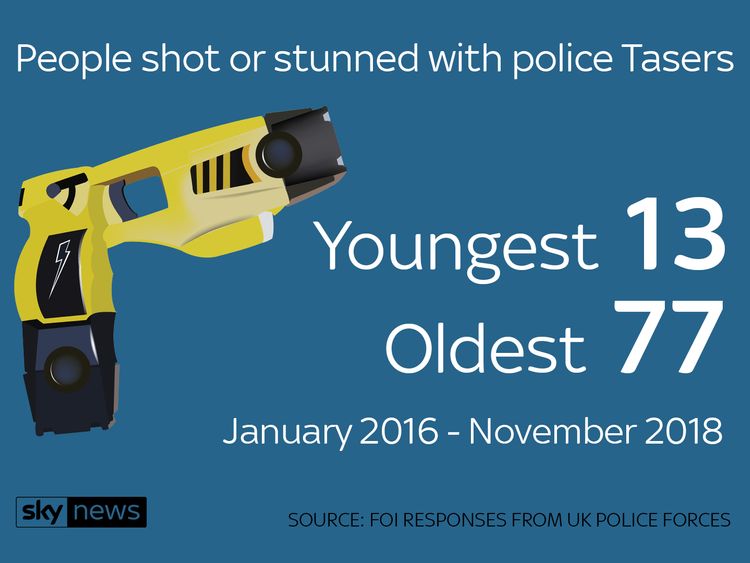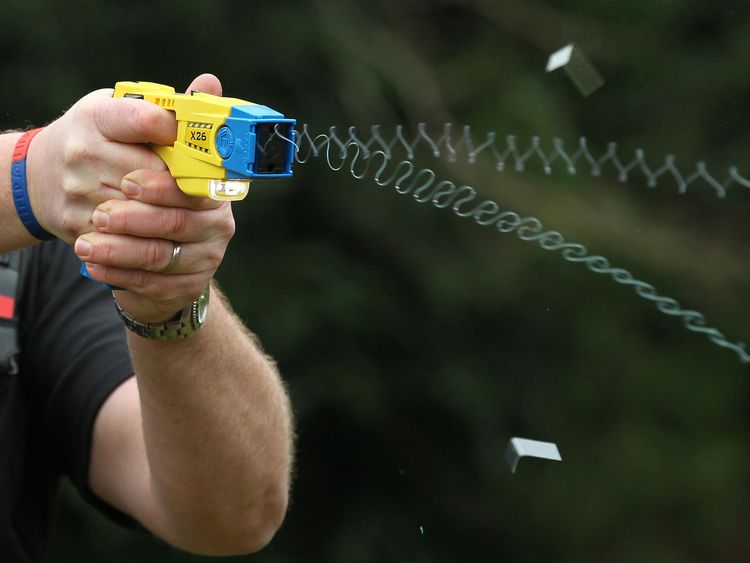Children as young as 13 and dozens of dogs tasered by police in last three years, figures show
A 77-year-old pensioner and at least 37 dogs were hit by the 50,000-volt stun guns between January 2016 and November 2018, according to data released by UK forces.
Campaigners warned police that Tasers are not “toy guns” and urged officers to stop firing them at children, saying young and elderly people are more at risk of serious health problems and even death from the weapons.
It comes after Home Office figures showed a sharp rise in the use of police Tasers in England and Wales in 2017-18, with 17,000 recorded incidents of the weapons being drawn – up 51% on the previous 12 months – including 2,000 occasions when they were discharged by officers.
Sky News sent freedom of information requests to every UK police force to find out the ages of people who had been shot or stunned with Tasers, and the number of incidents involving animals.
Merseyside Police said a Taser had been fired at a 13-year-old child in 2017, while Britain’s biggest force, the Metropolitan Police, discharged the weapon at a 77-year-old in 2016.
West Yorkshire Police tasered a 14-year-old boy involved in a suspected burglary in August after he allegedly attacked an officer.
And a 14-year-old girl was tasered “as a last resort tactic” by Cumbria Police after she claimed to have a machete and was threatening to harm herself.
Hampshire Police said it also fired a Taser at 14-year-old child, while Greater Manchester, West Midlands, Lancashire, Kent and Humberside police forces all said they had tasered children aged 15.
Elderly people hit with police Tasers included a 73-year-old in the West Midlands, a 71-year-old in Hampshire, a 71-year-old in Kent, a 70-year-old in South Yorkshire, a 65-year-old in Avon and Somerset and a 65-year-old in Greater Manchester.
Amnesty International UK criticised the use of Tasers on young and elderly people, warning they face a higher risk of fatal heart attacks, respiratory problems and psychological trauma from the weapons.
“A Taser is a 50,000-volt potential lethal weapon. It is not a toy gun,” the organisation’s spokesman Niall Couper said.
“People have died in the UK after being hit by a Taser.
“Police should not be given a Taser without proper training… not the average three-day course they receive now, but the months of training that the UK’s firearms officers get.
“Without that any increased roll-out will see more mistakes, more misuse and more tragedy.”
The Children’s Rights Alliance for England (CRAE) said it had seen a “deeply troubling” rise in incidents involving youngsters and urged police to stop firing Tasers at children.
“The fact that Tasers have been fired or used in drive stun mode [where the Taser is held against a target to cause pain, but not fired] on young children is a serious concern,” the group’s director Louise King said.
“Tasers can inflict intolerable pain and children have told us that the threat of violence from police carrying Tasers is really frightening.
“CRAE wants the use of Tasers on children to be eliminated in line with recommendations the UK has received from the UN. The government and the police need to take urgent action to protect children’s safety and well-being.”
Eighteen police forces revealed they had fired Tasers at a total of 37 animals – all dogs – since 2016, including pit bulls, Staffordshire bull terriers and a bullmastiff.
In one incident in October, an American bull dog called Narla was tasered to death in Leeds after officers attended a property to arrest a man.
People for the Ethical Treatment of Animals (PETA) voiced concerns about the use of Tasers on dogs, saying the weapons caused “extreme pain and can be deadly”.
“There are myriad sensible, easy capture methods available to authorities, including de-escalation techniques that rely on patience, behavioural understanding, and empathy,” Mimi Bekhechi, the organisation’s director of international programmes, said.
“PETA demands that UK police forces re-evaluate the animal-control training that their officers receive in order to ensure responsible Taser use, for everyone’s safety.”
The National Police Chiefs’ Council (NPCC) said decisions to use force against members of the public were “never taken lightly” and officers “always take into account of the age of a person”.
“The younger or more elderly their apparent age, the more careful officers will be,” added Deputy Assistant Commissioner Matt Twist, the NPCC’s lead on self defence and restraint.
“However there are some cases where individuals pose a significant threat to themselves or others and the use of force will be lawful, proportionate and necessary.
“While officers draw on training and experience, they ultimately must make real-time, split-second judgements to balance the vulnerability of the person against the risk of harm that they present.
“The use of Taser may be the best option in the circumstances, and we know that in 85% of cases just the threat of its use alone will resolve an incident without it being fired.”
He added that Tasers were “often preferable to the use of a baton, or restraint, which carry a greater risk of serious injury being caused and may lead to more force being needed”.
Source: Read Full Article





